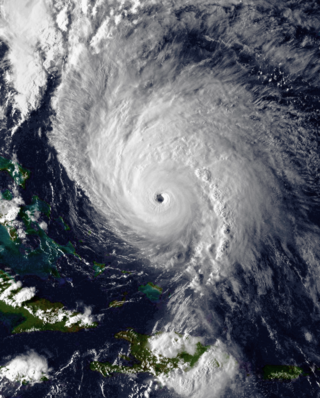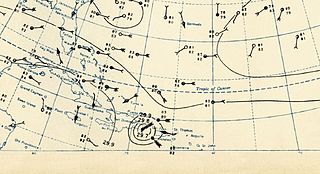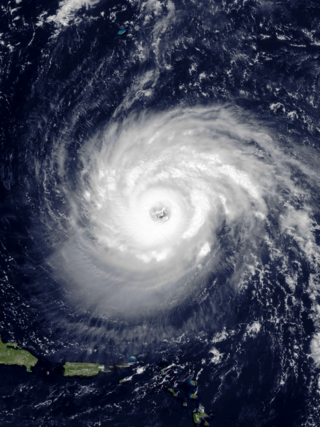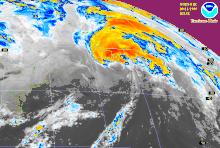
Hurricane Hortense was the first tropical cyclone to make landfall in Guadeloupe and Puerto Rico since Hurricane Hugo in 1989, and the second most intense hurricane during the 1996 Atlantic hurricane season. The eighth tropical cyclone, eighth named storm, and sixth hurricane of the season. Hortense developed on September 3 from a tropical wave in the central Atlantic Ocean. Initially a tropical depression, it headed westward without significant strengthening for four days due to unfavorable upper-level winds. While nearing the Lesser Antilles upper-level winds decreased, allowing the depression to become Tropical Storm Hortense on September 7. Hortense crossed Guadeloupe on September 8 and entered the Caribbean Sea. By on the following day, it was upgraded to a hurricane while curving northwestward. Hortense made landfall in Puerto Rico on September 9 and brushed the Dominican Republic shortly thereafter. After re-entering the Atlantic, Hortense began to substantially strengthen and peaked as a 140 mph (220 km/h) Category 4 hurricane early on September 13. Thereafter, the storm steadily weakened as it tracked rapidly north-northeastward. Early on September 15, Hortense made landfall in Nova Scotia as a minimal Category 1 hurricane. It quickly weakened further to a tropical storm before re-entering the Atlantic to the south of Newfoundland. Late on September 15, Hortense transitioned into an extratropical cyclone and subsequently merged with a frontal system about 24 hours later.

Hurricane Lenny was the strongest November Atlantic hurricane since the 1932 Cuba hurricane. It was the twelfth tropical storm, eighth hurricane, and record-breaking fifth Category 4 hurricane in the 1999 Atlantic hurricane season. Lenny formed on November 13 in the western Caribbean Sea at around 18:00 UTC and went on to form and maintain an unusual and unprecedented easterly track for its entire duration, which gave it the common nickname, "Wrong Way Lenny". It attained hurricane status south of Jamaica on November 15 and passed south of Hispaniola and Puerto Rico over the next few days. Lenny rapidly intensified over the northeastern Caribbean on November 17, attaining peak winds of 155 mph (249 km/h) about 21 mi (34 km) south of Saint Croix in the United States Virgin Islands. It gradually weakened while moving through the Leeward Islands, eventually dissipating on November 23 over the open Atlantic Ocean.

The 1995 Atlantic hurricane season was a very active Atlantic hurricane season, and is considered to be the start of an ongoing era of high-activity tropical cyclone formation. The season produced twenty-one tropical cyclones, nineteen named storms, as well as eleven hurricanes and five major hurricanes. The season officially began on June 1 and ended on November 30, dates which conventionally delimit the period of each year when most tropical cyclones develop in the Atlantic basin. The first tropical cyclone, Hurricane Allison, developed on June 2, while the season's final storm, Hurricane Tanya, transitioned into an extratropical cyclone on November 1. The very active Atlantic hurricane activity in 1995 was caused by La Niña conditions, which also influenced an inactive Pacific hurricane season. It was tied with 1887 Atlantic hurricane season with 19 named storms, which was later equalled by the 2010, 2011, and 2012 seasons.

Hurricane Klaus was a minimal Atlantic hurricane that dropped heavy rainfall across the Lesser Antilles in October 1990. The eleventh tropical cyclone and sixth hurricane of the 1990 Atlantic hurricane season, Klaus developed from a tropical wave on October 3 a short distance east of Dominica. It drifted northwestward, and quickly intensified to attain hurricane status on October 5. Though its closest approach to the Lesser Antilles was within 12 miles (19 km), the strongest winds remained to its northeast due to strong wind shear, which caused Klaus to steadily weaken. After deteriorating into a tropical depression, Klaus briefly restrengthened over the Bahamas before dissipating on October 9 under the influence of developing tropical storm, Marco.

Hurricane Marilyn was the most powerful hurricane to strike the Virgin Islands since Hurricane Hugo of 1989, and the third such tropical cyclone in roughly a two-week time span to strike or impact the Leeward Islands, the others being Hurricane Iris and the much more powerful and destructive Hurricane Luis. The thirteenth named storm, seventh hurricane and third major hurricane of the extremely active 1995 Atlantic hurricane season, Marilyn formed on September 12 as a tropical depression from a tropical wave that moved off the coast of Africa on September 7. After formation, the storm quickly became a tropical storm, and steadily intensified into a hurricane by the time it struck the Lesser Antilles on September 14 at Category 1 strength. Entering the northeastern Caribbean Sea, rapid intensification ensued and it peaked on September 16 north of Puerto Rico as a Category 3 hurricane shortly after it had impacted the U.S. Virgin Islands. A Hurricane Hunter reconnaissance flight reported hail, which is unusual for tropical cyclones. After heading north past Bermuda, Marilyn weakened and became extratropical on September 22. The remnant circulation wandered the Atlantic Ocean from September 23 – October 1, just south of Nova Scotia.

Hurricane Dog was the most intense hurricane in the 1950 Atlantic hurricane season. Prior to reanalysis by the Hurricane Research Division in 2014, it was considered one of the strongest Atlantic hurricanes on record, equivalent to Category 5 status on the modern Saffir-Simpson scale, with winds of 185 miles per hour (298 km/h). The fourth named storm of the season, Dog developed on August 30 to the east of Antigua; after passing through the northern Lesser Antilles, it turned to the north and intensified into a Category 4 hurricane. Dog reached its peak intensity with winds of 145 mph (230 km/h) over the open Atlantic, and after weakening it passed within 200 miles (320 km) of Cape Cod, Massachusetts. The storm became extratropical on September 12.

The 1930 Dominican Republic hurricane, also known as Hurricane San Zenón, was a small but intense and deadly tropical cyclone that severely impacted areas of the Greater Antilles, particularly the Dominican Republic, where an estimated 2,000 to 8,000 people died. The second of three known tropical cyclones in the 1930 Atlantic hurricane season, the system was first observed on August 29 to the east of the Lesser Antilles, and made landfall in the Dominican Republic at Category 4 strength on the modern Saffir-Simpson Scale. Later, it also struck Cuba and the U.S. states of Florida and North Carolina, with less severe effects.

Hurricane Erika was the strongest and longest-lasting tropical cyclone in the 1997 Atlantic hurricane season. It developed from a tropical wave on September 3 and moved west-northwestward across the tropical Atlantic Ocean, steadily intensifying until it attained hurricane status on September 4, becoming the fifth named storm and third hurricane of the season. Erika passed a short distance to the north of the Lesser Antilles, and later turned to the north in response to an approaching trough. The hurricane quickly strengthened to become the only major hurricane of the season, reaching maximum sustained winds of 125 mph (201 km/h) on September 8; after maintaining its peak strength for 24 hours, Erika began to weaken as it passed over cooler waters. It turned to the east, weakened to a tropical storm, and became extratropical after passing near the Azores archipelago.

Hurricane Jose was the fourteenth tropical cyclone, tenth named storm, and seventh hurricane of the annual hurricane season that caused moderate damage in the Lesser Antilles in October 1999. Jose developed from a tropical wave several hundred miles east of the Windward Islands on October 17. The depression intensified and was subsequently upgraded to Tropical Storm Jose on October 18. The storm tracked northwestward and was upgraded to a hurricane the following day as it approached the northern Leeward Islands. Jose briefly peaked as a Category 2 hurricane with winds of 100 mph (160 km/h) on October 20. However, wind shear weakened the storm back to a Category 1 hurricane before it struck Antigua. Further deterioration occurred and Jose weakened to a tropical storm before landfall in Tortola on October 21. While located north of Puerto Rico on October 22, the storm turned northward, shortly before curving north-northeastward. Wind shear decreased, allowing Jose to re-intensify into a hurricane while passing east of Bermuda on October 24. However, on the following day, wind shear increased again, while sea surface temperatures decreased, causing Jose to weaken and quickly transition into an extratropical cyclone.

Hurricane Debby caused minor damage in the Greater and Lesser Antilles in August 2000. The seventh tropical cyclone, fourth named storm, and second hurricane of the annual season, Debby developed from a tropical wave east of the Lesser Antilles on August 19. Favorable conditions allowed the depression to become Tropical Storm Debby early on August 20, and further strengthening into a hurricane occurred 24 hours later. Sustained winds peaked at 85 mph (137 km/h) on August 21. Debby made three landfalls on August 22, in Barbuda, Saint Barthélemy, and Virgin Gorda, before re-entering the Atlantic north of Puerto Rico. As Debby moved parallel to the north coast of Hispaniola late on August 23, it weakened back to a tropical storm. The storm tracked westward and weakened further, instead of approaching Florida and strengthening into a major hurricane. While south of eastern Cuba on August 24, Debby was downgraded to a tropical depression, six hours before completely dissipating.

Hurricane Iris was the first of three tropical cyclones to affect the Lesser Antilles in a three-week period, preceding the more destructive hurricanes Luis and Marilyn. The ninth named storm and fifth hurricane of the 1995 Atlantic hurricane season, Iris developed from a tropical wave to the east of the Lesser Antilles on August 22 and attained hurricane status within 30 hours. The hurricane weakened to a tropical storm before crossing the islands of the eastern Caribbean from August 26 through August 28. During that time, Iris became one of four active tropical storms in the Atlantic basin. Earlier it had interacted with Hurricane Humberto, and beginning on August 30, Iris interacted with Tropical Storm Karen. Iris re-intensified into a hurricane and attained peak sustained winds of 110 mph (175 km/h) while moving slowly across the central Atlantic. The hurricane accelerated to the north and absorbed a dissipating Karen on September 3. Iris weakened to a tropical storm and became extratropical on September 4, though its remnants re-attained hurricane-force winds, before affecting western Europe on September 7. The storm dissipated soon afterward.

Hurricane Dean was a strong tropical cyclone that affected the United States and Atlantic Canada while remaining offshore in early August 1989. The fourth named storm and second hurricane of the 1989 Atlantic hurricane season, Dean formed on July 31 and reached tropical storm status the following day east of the Leeward Islands. Dean brushed the northern Leeward Islands as a Category 1 hurricane on the Saffir–Simpson Hurricane Scale, bringing light rain but producing no damage, before turning northward and striking Bermuda as a Category 2 hurricane. It continued northward before making landfall in southeastern Newfoundland.

The effects of Hurricane Georges in the Lesser Antilles were minimal in certain islands and major on others. Georges had formed on September 15, 1998, off the African coast. It had quickly strengthened into a Category 4 hurricane on the Saffir–Simpson scale on September 20 when it struck the Lesser Antilles with 115 mph (185 km/h) winds. The islands affected include Antigua, Barbuda, the British Virgin Islands, the United States Virgin Islands, Montserrat, Guadeloupe, Dominica, St. Maarten. St. Kitts and Nevis were also affected and sustained the most damage at US$484 million.

The 1852 Atlantic hurricane season was one of only three Atlantic hurricane seasons in which every known tropical cyclone attained hurricane status. Five tropical cyclones were reported during the season, which lasted from late August through the middle of October; these dates fall within the range of most Atlantic tropical cyclone activity, and none of the cyclones coexisted with another. Though there were officially five tropical cyclones in the season, hurricane scholar Michael Chenoweth assessed two of the cyclones as being the same storm. There may have been other unconfirmed tropical cyclones during the season, as meteorologist Christopher Landsea estimated that up to six storms were missed each year from the official database; this estimate was due to small tropical cyclone size, sparse ship reports, and relatively unpopulated coastlines.

Hurricane Baker was a Category 2 hurricane that affected the Leeward Islands, Greater Antilles, and the Gulf Coast of the United States. The tropical cyclone was the second tropical storm and second hurricane of the 1950 Atlantic hurricane season. Originating as a tropical depression east of the Windward Islands on August 18, Baker became a tropical storm on August 19, and further intensified into a hurricane on August 21. It attained an initial peak intensity with maximum sustained winds of 100 mph (160 km/h) on August 22 before weakening to a tropical storm as it made landfall on the island of Antigua. Baker weakened to a tropical depression late on August 23 while southwest of Puerto Rico. By the following morning, it had restrengthened into a tropical storm, though a landfall in Cuba caused it to weaken once again. Entering the Gulf of Mexico, Baker began to strengthen once more, regaining hurricane strength on August 29 and reaching its peak intensity with maximum sustained winds of 105 mph (169 km/h) early the following day. The cyclone weakened before making its final landfall in the United States near Gulf Shores, Alabama, with winds of 85 mph (137 km/h). Hurricane Baker produced extensive damage in the Lesser Antilles and Cuba, but impacts were minimal in the United States.

Hurricane Omar was a powerful tropical cyclone that took an unusual southwest to northeast track through the eastern Caribbean Sea during mid-October 2008. Forming out of a tropical disturbance on October 13, Omar initially moved slowly in the eastern Caribbean Sea. By October 15, Omar began to quickly intensify as deep convection developed around the center of circulation. Later that day, an eye developed and the storm began to accelerate to the northeast. Early on October 16, Omar reached its peak intensity with maximum winds of 130 mph (210 km/h) and a barometric pressure of 958 mbar. Shortly after, the hurricane rapidly weakened to Category 1 intensity. After slightly re-strengthening the next day, Omar weakened to a tropical storm before degenerating into a non-convective low pressure area. The remnants of Omar persisted until October 21, at which time they dissipated to the west of the Azores.

Hurricane Gustav was the only major hurricane that formed during the 1990 Atlantic hurricane season. Developing out of a tropical wave on August 24, Gustav tracked westward across the Atlantic Ocean, steadily intensifying. The storm reached hurricane-status on August 26 and reached its initial peak intensity as a strong Category 2 hurricane the following day. After turning towards the north and weakening due to increased wind shear, the storm encountered more favorable conditions and re-intensified, attaining peak winds of 120 mph (190 km/h) around 0600 UTC on August 31. Gradual weakening took place in the following days. on September 2, the former hurricane underwent an extratropical transition and dissipated shortly after completing it. At that time, the system was located roughly 230 miles (370 km) south of Iceland.

Tropical Storm Erika was a short-lived tropical cyclone that brought minor impacts to the Lesser Antilles. The fifth named storm of the 2009 Atlantic hurricane season, Erika originated out of a tropical wave on September 1 near the Lesser Antilles. Although it was a disorganized system, it was immediately declared a tropical storm, rather than a tropical depression. Later that day, the system reached its peak intensity with winds of 50 mph (85 km/h) and a barometric pressure of 1004 mbar. Increased wind shear caused the storm to weaken shortly thereafter, with Erika barely maintaining tropical storm-status by September 2. Later that day, the storm passed over the island of Guadeloupe and entered the Caribbean Sea. On September 3, Erika weakened to a tropical depression as the low pressure center became fully displaced from convective activity. Later that day, the system degenerated into a remnant low before dissipating near Puerto Rico on September 4.

Tropical Storm Christine was the first tropical cyclone to form as far east as longitude 30° W in the Atlantic Ocean since Tropical Storm Ginger in 1967. Forming as a tropical depression over the country of Guinea on August 25, 1973, the system tracked nearly due west for several days before intensifying into a tropical storm on August 28. However, the National Hurricane Center did not issue their first advisory on the system until its intensity was confirmed by a reconnaissance aircraft on August 30. Turning slightly northward, Christine gradually intensified, attaining its peak strength on September 2. At that time, the storm had winds of 70 mph (110 km/h) and a minimum pressure of 996 mbar, just below hurricane status. Shortly after, increasing wind shear caused the system to quickly weaken. By September 4, Christine had been downgraded to a tropical depression as it tracked through the Leeward Islands. After degenerating into a tropical wave, the cyclone's remnants fully dissipated on September 6.

Hurricane Katia was a fairly intense Cape Verde hurricane that had substantial impact across Europe as a post-tropical cyclone. The eleventh named storm, second hurricane, and second major hurricane of the active 2011 Atlantic hurricane season, Katia originated as a tropical depression from a tropical wave over the eastern Atlantic on August 29. It intensified into a tropical storm the following day and further developed into a hurricane by September 1, although unfavorable atmospheric conditions hindered strengthening thereafter. As the storm began to recurve over the western Atlantic, a more hospitable regime allowed Katia to become a major hurricane by September 5 and peak as a Category 4 hurricane with winds of 140 mph (230 km/h) that afternoon. Internal core processes, increased wind shear, an impinging cold front, and increasingly cool ocean temperatures all prompted the cyclone to weaken almost immediately after peak, and Katia ultimately transitioned into an extratropical cyclone on September 10.



























